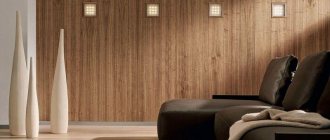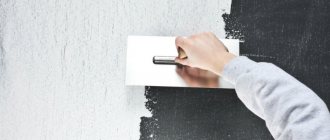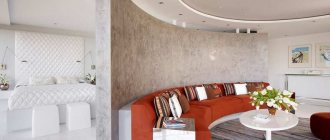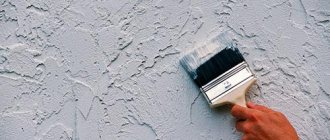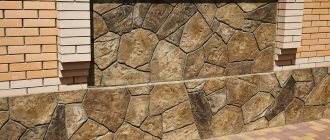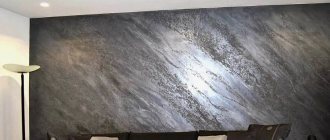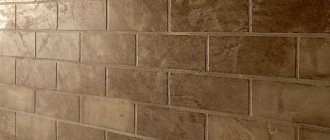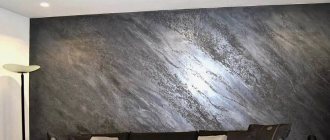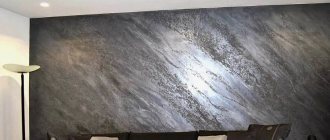Types and applications
Plaster that imitates wood differs in application technique, composition, texture, color range, etc. The material can be structural and textured.
Structural plaster allows you to create an aesthetic pattern with delicate tints of color. Ceramic or synthetic granules, crushed stone and rolled stone chips, shell particles, natural and synthetic fibers, and metal dust are used as modeling ingredients.
Structural components play the role of reinforcing elements in the composition, because give the mass greater strength, relief, and durability. The applied plaster creates the effect of expanding the space.
Based on the type of binder base, structural putty is divided into the following subtypes:
- mineral
- cement or lime;
- silicate
— based on liquid glass;
- acrylic
— with the addition of latex;
- silicone
- with polymers in the composition.
Structural plaster is used for interior or facade decoration. The advantages of the material include the ability to correct defects on the surface, undemanding quality of the base, good thermal insulation characteristics, and ease of application. Using the mixture you can create relief and texture. When using a type of plaster, it is important to take into account the large weight of the finishing material (up to 4.5 kg per 1 m²).
Textured plaster has a coarse structure.
The following are used as fillers:
- mica;
- cotton fibers;
- small stones or stone chips;
- linen;
- granite or marble granules;
- wood.
Textured plaster is used for interior and facade decoration and can be applied to surfaces made of different materials (in addition to plasterboard). The advantage of the composition is its dense application to the base, the ability to correct unevenness and defects on the walls. The finishing mixture is used at a temperature not lower than +7°C. Work is carried out only in dry weather, because... at high humidity, the applied composition will be damaged by mold.
This type of wood plaster is characterized by strength, wear resistance, durability, resistance to temperature changes, mechanical damage, mold, and mildew. The textured construction mixture is affordable and can be used for finishing in rooms with high levels of air humidity.
However, it is necessary to take into account the step-by-step technology of applying the composition. You can add colors to the mixture or apply paint to the putty after completing the work. The type of finishing is optimal for decorating rooms in rustic, classic, country, etc. styles.
Wood imitation spatula - options for finishing tools
Where work on design is underway, materials begin to take on lines that are unusual for them; for example, a spatula to imitate wood embodies plaster in a panel made of expensive wood.
It happens that another type of this tool does all the work for the woodworm, creating a wall covering decorated like a bark beetle. In addition, the spatula can even change the brush. How? Now we'll tell you.
Spatula for imitating wood - we work with an applicator
What is more affordable – plaster or wood panels? Of course, the price of the first of the materials is incomparably lower. But all the time you want something more magnificent than a smooth plastered surface, and your imagination turns on and gives birth to an idea. Actually, this is how a spatula for imitating wood arose, which also acquired the name “applicator”. Of course, the complete illusion of wood fibers cannot be achieved only with a tool; you need to know the technique of finishing the coating, but the specific features of a completely different material will radically change the plaster.
The shaped spatula has a special direction - not to level, but to create unevenness that imitates wood fibers, which is why the surface of the tool is made of arched ribs, which, pressing into the new plaster layer applied to the wall surface, create an exceptional texture. Using a spatula to create a wood effect is very easy. With sweeping, light movements we move along the wall covering from top to bottom, and now we are planning to make an oblique cut of the wood on the surface of the wall. And after painting it in a suitable color, your living space will be finished with wood panels.
Plaster spatula for decorative work – it’s up to you to choose
Finishing a plastered surface does not only involve the use of special tools. plaster spatula for decorative work can also help you do the job correctly.
. The important features of such a tool are a perfectly polished steel surface for work, a sharp, completely smooth edge and a comfortable handle. Everything else is a matter of technology. It must be said that you need to apply the “Venetian”.
You work like a designer, with bold, partly overlapping strokes, applying the mixture to the surface that has been prepared. Much darker areas will appear where the layering occurs, eventually resulting in a marbled effect. As for the “Bark Beetle” technique, you do not need to purchase a decorative mixture in order to get the desired effect; you do not need a special tool. For example, when decorating walls with Venetian, some craftsmen misunderstand home owners by saying that a specialized Venetian spatula is needed.
Yes, there actually is a similar tool, but it is not rare or special, it is just a trowel for plaster for decorative work, comfortable, made of low-carbon steel, with a polished surface to which the composition does not stick. A traditional bark beetle spatula is also used; it is used to apply and smooth the mixture with granular filling so that the thickness of the plaster layer is not greater than the size of the fractions of marble or granite chips.
What's so good about this finish?
The advantages of decorative plaster material are as follows:
- low cost compared to wood finishing;
- durability;
- wear resistance;
- resistance to high air humidity;
- no shrinkage;
- resistance to temperature changes;
- fire resistance;
- wide range of shades;
- various application methods;
- possibility of restoration of damaged areas;
- environmental friendliness of the composition;
- ease of application;
- resistance to sunlight and precipitation;
- versatility of use for exterior and interior decoration.
Wood imitation
Natural wood in the form of solid wood or veneer of various types, as a result of its high aesthetic and performance properties, has been widely used for many decades for finishing the interiors of residential buildings and apartments. However, for one reason or another, the use of this material is impractical and sometimes even impossible. In such cases, finishing specialists perform an absolutely realistic imitation of wood from polymer clay, decorative plaster or even paint. In this article we will look at all three methods. After reading this article, you will know exactly how to make imitation wood and what tools you will need for this.
Natural wood in the form of solid wood or veneer of various types, as a result of its high aesthetic and performance properties, has been widely used for many decades for finishing the interiors of residential buildings and apartments. However, for one reason or another, the use of this material is impractical and sometimes even impossible. In such cases, finishing specialists perform an absolutely realistic imitation of wood from polymer clay, decorative plaster or even paint. In this article we will look at all three methods. After reading this article, you will know exactly how to make imitation wood and what tools you will need for this.
Imitation of wood texture with plaster
A true master plasterer can reproduce the structure and texture of any finishing material, and even expensive types of wood, using simple tools and plaster. Decorative wood plaster is one of the favorite solutions of designers. At first glance, the work may seem very complicated, but if you figure it out, everything is very simple.
Imitation of wood using decorative plaster involves creating:
- textures of wood of various types in longitudinal section
- cross-section textures
- tree structure eaten away by wood beetles
- tree bark stylization
- petrified wood structures.
The material, set of tools and technique for carrying out the work depend on the chosen design.
Any type of plaster is suitable for this type of work:
- cement-sand
- cement-lime
- plaster
- acrylic
- silicone.
In order to create an imitation of tree bark or the texture of bark beetles, it is worth purchasing ready-made structural plaster, which contains coarse filler. With this material you will get a particularly relief pattern.
It is very convenient to use ready-made acrylic and silicone masses. Such compositions do not harden for a long time, in comparison with lime or gypsum compositions, which means you can correct the work if deficiencies are discovered.
To complete the work you will need the following tools:
- spatulas, different sizes and shapes. You will need both metal and rubber, comb with a straight blade, flexible and rigid
- squeegee spatulas with different notches on the blade
- trowel
- rollers with relief patterns on the surface
- brushes with hard bristles.
The Japanese rubber spatula is very easy to use and interesting, one surface of which is designed to create a relief of a longitudinal cut, the second - for creating knots and annual rings.
However, it is not necessary to purchase expensive professional tools if you have a small area to process. Expensive embossed rollers can be replaced with simple paint rollers by wrapping them with improvised materials - thread, tape, plastic film, foil. Uneven folds will give a relief pattern that is very similar to a longitudinal section of wood.
Before starting work, you should definitely try it on a piece of cardboard - apply plaster and make the desired relief.
The procedure for creating wood texture using plaster is approximately as follows:
- Cover a small piece of the wall with plaster using a stainless steel trowel, level it to obtain a layer 3–6 mm thick. A spatula will help you smooth the surface as much as possible.
- Using any object: a stiff shoe brush, a special brush with stiff bristles, or a professional rubber roller, apply wavy furrows. In this case, you need to apply uneven pressure on the tool. The furrows can be directed vertically, horizontally or at an angle. The tool must be cleaned after each pass. Before each subsequent operation, let the plaster dry a little.
- Now you can rub the wall with a smooth hard spatula parallel to the relief to form a glossy surface and dry for 30 minutes
- Distribute the prepared and tinted primer over the wall with a roller or brush. It is the brush that will help the primer penetrate into all the grooves of the relief. The wall must be left to dry according to the instructions on the primer package.
- cover with a final coat of paint, dry
- Using a special spatula, smooth the surface.
The steps listed above will help you decorate an entire wall or a small panel.
- does not burn
- she's easy to work with
- does not take up room space
- its price is several times less than wooden panels.
Imitation of wood using polymer clay
Polymer clay is a moderately soft plastic material based on polyvinyl chloride, which polymerizes at temperatures from 100 to 130 ° C, losing its plastic properties. This material is very similar to plasticine. You can buy it in small bars, and the number of shades is simply huge. In addition, it is worth noting that the price of this material is more than affordable.
Main and auxiliary tools
The main tools for applying the mixture are:
- trowel;
- construction mixer;
- spatulas of different shapes and sizes;
- masking tape;
- rubber rollers;
- brushes of different shapes;
- building level;
- mixing containers;
- rulers;
- perforator;
- sponge;
- a ladle for transferring the solution to the panel;
- rule;
- ironer;
- clean cloth.
To imitate various wooden bases, you will additionally need a choice of spatulas with a serrated edge, a rubber stamp, a stiff brush, a decorative roller for wood, a silicone stamp to imitate wooden boards, a fluted brush, a palette knife, etc.
The list of tools may vary depending on the design solution, type of base, wall panel materials, and technology for applying the composition.
Materials used and preparation for application
For work you will need a primer, plaster selected in accordance with the interior design, a painting composition, etc. To strengthen unstable foundations, a metal reinforcing mesh is required. The coating can be secured with a transparent or translucent varnish. When creating the effect of an aged surface, craquelure varnish may be required.
Before applying the plaster mixture, the base should be prepared for high-quality and durable adhesion of the finishing mixture to the surface. You will need to clean old wallpaper, dyes, varnish and remove fasteners. Hard-to-reach areas are cleaned with a spatula. Cracks, holes and crevices are filled with a primer; after drying, the surface must be vacuumed. The walls are primed in 2 layers. It is optimal to use a deep penetration primer. Each layer is thoroughly dried before applying the next.
Technology and application methods
Decorative plaster “wood” includes solid components, with the help of which, after rubbing the finishing layer, grooves are formed, similar to tree cuts. The packaging indicates the shade, application method and final result.
The following coatings can be made using plaster:
- tree bark effect;
- “bark beetle” effect;
- cross cuts;
- laying boards;
- wooden panel, etc.
The techniques for applying plaster using a stamp, a stiff brush, a shaped spatula, a silicone matrix, etc. differ.
Bark of tree
Imitation of the surface of tree bark is used for finishing loggias, gazebos, building facades, and fences. This material is durable, easy and quick to apply. The dry finishing mixture will need to be diluted with water, the mixture is applied to the prepared base using a trowel, the layer should be even, up to 2-3 mm thick.
Then, with a roller dipped in water, a relief pattern is made under the tree bark. After the surface has dried for 20-30 minutes, the plaster is moistened with a spray bottle and the protrusions are smoothed out. The work is carried out with a spatula, imitation bark cracks are left between the smooth areas. After smoothing, wipe the surface with a damp cloth. It will take 24 hours for the treated surface to dry. Then small defects are removed with a spatula.
Finally, a finishing layer of wax or non-woven glue mixed with acrylic varnish is applied in a ratio of 1:0.5. You can add color to the adhesive mixture. The finishing compound is applied with a trowel, the surface is smoothed, imperfections are removed with a damp sponge and the surface is smoothed with a trowel again. To create contrasting transitions, you can apply a little dye of a different shade using a sponge.
Application of the die
An imitation of a wood surface can be created by applying plaster with a rubberized stamp.
The work is performed in the following sequence:
- A layer of building mixture 2-2.5 mm thick is applied to the wall.
- Then the stamp is passed over the applied material, making vertical and horizontal movements. The tool must be easily rocked from one edge to another to create a natural wood pattern.
- After drying, the panel is sanded with fine-grained sandpaper.
- The plastered surface is painted and covered with a layer of wax or clear varnish.
Application of the brush
Finishing with plaster using a stiff brush allows you to create a textured pattern. The tool is drawn along the main direction of the lines imitating wood. Movements should be light, and any remaining plaster mortar should be regularly removed from the bristles. The dried coating is slightly adjusted with a spatula to eliminate protrusions and irregularities. Finally, the surface can be treated with wax or translucent varnish.
Using a shaped spatula
A shaped spatula with a serrated blade allows you to imitate a cut on wood. First, a base layer of plaster is applied, then a spatula is passed over the dried material with sinuous movements, turning the working tool. You can emphasize the engraving on the surface by applying special wax or translucent varnish. To age the surface, special varnishing materials can be used.
How to make a wood-look spatula with your own hands
To treat small areas with a spatula, you can use devices made of plastic or other improvised means.
To make a tool from a lid, you will need to draw the contours of a spatula on the plastic and cut out 3 parts with a construction knife or sharp scissors:
- wide
, on which large notches are formed using a stationery knife;
- average
with small teeth;
- narrow
, the working edge of which is left smooth.
Using a sharp knife, you can make notches on ready-made plastic spatulas.
Application of silicone matrix
Manufacturers offer special silicone matrices for reproducing the texture of wood using the imprint technique. Using a matrix tape and a roller, you can imitate boards; short versions are used to imprint bark. The finishing is used to decorate facades, loggias, living rooms, and hallways in office premises.
The work is carried out in compliance with the following stages:
- After applying the plaster, a matrix tape moistened with water is applied to the surface.
- The strip is pressed with a roller to obtain a high-quality print.
- Using a wooden stick and other tools, grooves are created along the tape that imitate joints between wooden boards.
- Then the matrix is carefully removed and the steps are repeated in other areas.
- The seams between the imitation boards are smoothed with a narrow, hard brush dipped in water.
- After drying, the coating is treated with fine-grained sheets of sandpaper.
Making wooden panels
Plaster can be used to create wooden panels. The interior element allows you to diversify monochrome interiors. Thanks to volumetric plaster, it is possible to sculpt patterns based on the finishing material. Using the mixture, you can reproduce landscapes, complex geometric and floral patterns on panels.
The image on the panel is durable, resistant to temperature changes and mechanical damage. Using the material, you can create original design solutions and correct surface unevenness. The panels are performed indoors, because the composition is not used for facade finishing.
The typesetting panel is created using masking tape 0.5 cm wide. Before finishing, the wall is outlined and tapes are glued to the surface. Then the solution is applied to the surface in a layer of up to 0.5 cm.
Areas with imitation boards are given the necessary wooden texture using a brush, stamp or shaped spatula. After the layer of plaster has dried, the tape is removed, the edges of the panel are trimmed and smoothed using a semi-dry brush.
Performing the “bark beetle” effect
Decorative wood plaster can be created with a “bark beetle” effect. A structural composition is applied to the surface with a trowel. The coating is dried and floated to create a bark beetle pattern. Uneven protrusions need to be smoothed with a trowel or spatula. After the finish has dried, the surface is cleaned with sheets of sandpaper.
Bark beetle plaster is used for interior and exterior decoration. However, the material is not used for surface restoration. The advantage of this coating is the low weight of the mixture due to the mineral chips in the composition. The type of plaster is environmentally friendly and durable. Manufacturers offer finishing options in different colors.
Imitation of wood texture with plaster
One of the inexpensive and proven ways to obtain an effective wood-look finish is decorative plaster. Types that imitate the texture of trees such as oak, ash, cherry, and walnut are sold. Plaster has significant advantages over other materials:
- suitable for most surfaces;
- you can cover both small pieces and the entire area;
- withstands adverse conditions, temperature changes and is therefore suitable for outdoor use;
- non-flammable;
- You can easily and quickly restore the damaged area.
The main disadvantage is that the imitation only looks good from a long distance. In addition, unlike real wood, the strength and wear resistance are several times less.
Which plaster is suitable
The choice of material depends on the further conditions of use of the surface. For example, the façade of a building is made of putty. Cement plaster works well on concrete. Indoors, you can give preference to materials based on gypsum, acrylic or silicone. The bark or wormholes made by beetles are well conveyed by relief structural plaster with coarse granules. Ready-made mixtures of acrylic and silicone are practical to use. They do not harden instantly and allow you to adjust the process.
Required Tools
The range of devices is determined after choosing the breed that needs to be created. You may need:
- squeegee spatulas with different notches;
- various spatulas (metal, rubber, flexible and others);
- rollers with relief patterns;
- brushes with hard bristles;
- trowel.
It is advisable to purchase expensive equipment only for large volumes of work or when they are carried out to order. In most cases, you can get by with improvised means. So, it’s easy to add texture to a regular paint roller by wrapping it with tape, thread or film.
The procedure for creating wood texture
At first glance, the work may seem quite painstaking, but understanding the technology will not be difficult. Before you start working, you should practice on a piece of cardboard. Follow the following sequence of actions:
- Treat a small area with putty and level it to a thickness of 6 mm. Carefully smooth the surface with a spatula.
- Next, apply wavy grooves in a vertical, horizontal direction or at an angle. After each pass, the instrument is cleaned.
- Then we form a glossy base on the wall with a hard spatula.
- The plaster should dry for 30 minutes.
- Using a brush, distribute the primer over the surface. It is important that it gets into all the cracks.
- Then the surface is coated with paint, dried and, if necessary, smoothed.
Coloring
To emphasize the imitation of wood texture, the applied plaster composition is coated with a translucent paint and varnish.
The dye is prepared according to the following recipe:
- a little primer is poured into the container;
- A water-based color is added to the composition (several shades can be combined);
- a standard white water-based dye is introduced into the mass;
- add powdered wallpaper glue.
The solution is thoroughly mixed after incorporating each component. Painting is done with a wide brush, the remaining composition is removed with a rubber spatula.
To enhance the emphasis of the wood grain and obtain a more saturated tone, experts recommend applying another 2-3 layers of dye of different shades.
For subsequent layers, use a mixture of color and water-based paint without glue or primer. To give wood-imitation plaster a light glossy shine, a pearlescent composition is added to the mixture. Each layer of dye is dried. Excess composition is removed with a rubber spatula.
